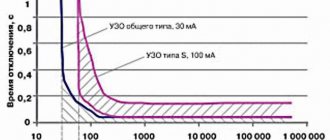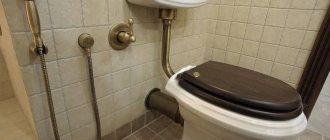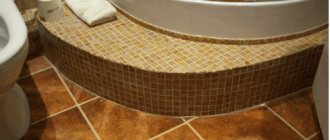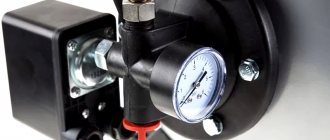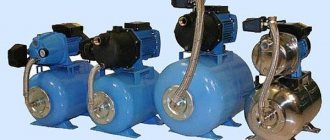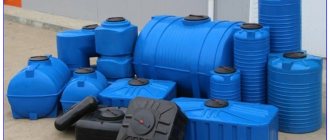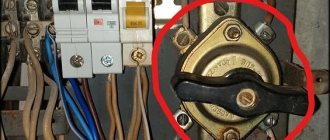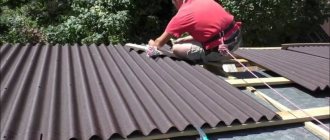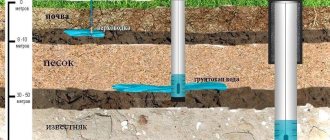High performance and equipment with modern technologies cannot provide a 100% guarantee against failure of the water supply system of a private home. The only thing that can protect you in such a situation is a special spare container. Let's consider what a storage tank for water supply is, what it is intended for and how it is used, what types there are and how to choose the right one based on volume and material, what are the main connection options, as well as how to properly combine it with a centralized and autonomous water supply system.
Storage tank with pump in the house Source stroy-podskazka.ru
Storage tank - what is it, purpose, application
Water, along with light and heat, is the primary factor in the life support of a home. Therefore, the slightest violation in her usual method of delivery leads to extreme discomfort. Until recently, the only way to solve this problem was to reserve a certain amount of water in bottles, canisters, and barrels. However, if not used for everyday needs, it quickly deteriorates and becomes unsuitable for drinking and cooking.
A modern way to solve this problem is a special water storage tank for the home, combined with both a centralized water supply and water intake from a well, well or natural reservoir. Such a reserve tank is used in the following series of cases:
- Periodic or emergency shutdown of centralized water supply, as well as when water is supplied not constantly, but according to a schedule.
- Low performance of an autonomous source.
- Frequent shutdowns of pumping stations due to power failures.
Drives can be very different in capacity, depending on the needs of the consumer Source ireland.apollo.com
- Clogging, silting and other technical malfunctions of a well or well.
- The supply system is completely autonomous - it functions only using imported water.
The peculiarity of a private water supply is such that these and many other small reasons can arise one after another, and sometimes simultaneously. At the same time, troubleshooting always requires a certain period of time, sometimes reaching several days or weeks.
In addition to ensuring stability in the water supply, the storage tank performs a number of other technical functions that are essential for equipment, fittings and pipelines:
- Equalizing pressure in the system.
- Prevention of water hammer.
- Reducing the load on pumps and their operating time.
- Increased equipment service life.
Advice! To conveniently and quickly activate the reserve water supply, the reserve tank must be connected to the water supply so that if the main supply is interrupted, the additional one is turned on automatically or by turning the valve.
The storage tank can be easily integrated into the home water supply scheme Source oboiman.ru
Main types of breakdowns
Modern manufacturers have learned to create excellent luxury water heating equipment. It uses gas to operate efficiently and rarely fails. However, even the best gas heaters cannot avoid breakdowns. The list of inevitable malfunctions includes:
- water leaks;
- poor heating of the liquid;
- discharge of power elements;
- weak water pressure;
- lack of gas.
Owners of gas boilers can repair some faults themselves. Anyone can change the batteries in the power supply. It is also easy to eliminate weak water pressure - perhaps excess scale has simply formed in the heat exchanger. To remove it, remove the heat exchanger and rinse thoroughly. For these purposes, you can also use special descaling liquids.
It is not difficult to solve the problem of poor water heating on your own. The main reason for such a malfunction is often contamination of the heat exchanger with soot. The solution to this problem is to remove the mentioned element and remove plaque. If more significant problems occur, you should contact a professional.
Design and principle of operation
A storage tank for water is a reservoir of a certain volume, equipped with the following devices:
- Inlet tube. Through it, the reservoir is filled from the main source - a well or a central pipeline.
- Float mechanism. This can be a regular float, similar to the device of a toilet flush cistern, or a special valve that, when the tank is full, turns off the supply pump or closes the tap.
- Drain pipe. To prevent the container from overfilling and causing flooding of the room, in case the float mechanism does not work, a drain tube is installed in the upper part, through which excess water is removed.
- Filter. There are several types of filter devices installed on the inlet artery - mesh, cyclonic and centrifugal type. The first is used when there is slight contamination, the last two are used when there are impurities visible to the naked eye. The filter mesh can also be mounted on the outlet pipe from the tank.
Modern filtration system for a storage tank Source terman-s.ru
- Drainage and cleaning tube. When using a container for a long time, even with a good filter, a layer of contaminating deposits inevitably accumulates at the bottom. A drainage pipe is used to periodically remove them.
- Luke. If a private house has a basement or basement, then a water storage tank is often installed there. However, with such a low location of the tank, it is almost impossible to install a drainage system. Therefore, for periodic cleaning, a hatch is required in the upper part, through which you can penetrate inside and clean the bottom of dirt.
- Diffuser. A device that disperses water flow similar to a watering can. Installed on the supply tube. Prevents active mixing of the upper layers with bottom sediments.
- Level. As a rule, the walls of the tank are opaque. Therefore, to accurately determine its fullness, a level is mounted.
Design of a membrane storage tank Source montagtrub.ru
See also: Catalog of companies that specialize in garden furniture and storage systems
- Ventilation pipe. Regardless of whether the container is equipped with a hatch or not, when closed it is a hermetically sealed capsule. Therefore, so that when opening the tap, an internal vacuum of air does not form, and this results in water retention, a ventilation valve or tube is installed in the very top part.
The mechanism of action of the reserve tank is largely determined by its location - if it is located at a sufficiently high level in relation to the receiver (faucet, shower, etc.), water can flow out of it by gravity, if lower or at the level, then under the pressure generated a pump specially installed for this purpose.
Varieties
Reserve tanks to ensure uninterrupted water supply are classified according to the following number of parameters:
- Shape - can be cylindrical, rectangular, square, etc.
- Type of construction - open and closed type, that is, with and without a hatch - completely sealed membrane.
- There are various types of housing material used – from stainless steel to food-grade plastic. At the same time, its composition must exclude harmful substances that can pass into water.
Storage containers most often have a plastic body Source septik.guru
- Capacities - depending on the conditions of use, the useful volume can be very different - from 10 liters to 1 m³, etc. It is also possible to combine several containers into one system.
- Purpose - for drinking and cooking, for watering the garden, for the heating system, for cold or hot water supply, for other technical needs.
- Installation features - vertical or horizontal placement, indoors or outdoors, on the surface, at height or underground.
Note! To ensure uninterrupted water supply to a private home, it is not necessary to purchase and install an additional pump for a storage tank. Special membrane hydraulic accumulators create a certain pressure - sufficient for convenient use of a tap, shower and other household needs.
What to look for when choosing?
Experts advise installing an expansion tank with a volume of 10% of the volume of the hot water boiler: a 100-liter boiler requires a 10-liter tank, a 200-liter boiler requires a 20-liter tank.
It is important to consider that a smaller capacity means the possibility of more frequent pressure surges. Do not forget that water is stored in the tank
This reserve may come in handy under certain circumstances.
You need to select a special hot water supply tank, for which such a possibility is provided structurally, indicated in the instructions. For example, heating system tanks require higher operating temperatures, but lower pressures. They provide the transfer of coolant at a “hotter” temperature, but the pressure there is relatively low. In such containers, little attention is paid to the hygienic characteristics of the materials. To help the consumer, tanks are made in different colors: blue, blue, white for water supply, red for heating. But it’s better to carefully read the product data sheet to avoid mistakes, since you can’t always trust the labeling.
The safety of using an expansion tank for water is determined by the material of the membrane and tank:
- rubber of natural origin - harmless in cold water, but you should not heat it above 50 degrees - negative reactions are possible;
- artificial rubber is suitable for water of various temperatures - up to boiling - without any consequences;
- rubber (ethylene-propylene) is similar in properties to artificial rubber - it has high performance properties;
- The tanks themselves are most often made of steel.
Another factor in choosing a tank is the manufacturer. A low price can often mean low quality of the product and, as a result, subsequent expensive repairs. A manufacturer with a name and reputation is not ready to sacrifice them, chasing fleeting benefits. They offer tanks and good quality components at reasonable prices.
First of all, pay attention to the membrane material (see above), since the service life of the tank, the quality and safety of the water depend on this
The price of the membrane is not an empty question if we are talking about a tank with a replaceable rubber band.
Capacity volume and material
When choosing a drive, in addition to other technical nuances, you first need to determine what material its body should be made of and what its usable volume should be for everyday needs.
A plastic container can be installed outdoors without additional protection Source sovet-ingenera.com
Material
Most often, the materials used in the manufacture of the tank body are:
- Polyvinyl chloride.
- Polypropylene.
- Cross-linked polyethylene.
- Stainless steel.
- Steel coated with a layer of waterproof coating - varnish, ceramics.
- Galvanization.
To equip drinking water supply and related household needs (washing dishes, showering, etc.) for a private home, food-grade plastic containers are most often chosen. Its main advantages over metal analogues are inertness, safety (does not emit harmful components), corrosion resistance, durability, light weight - which is convenient for transportation, installation and maintenance.
How to choose a drive
When choosing a tank, you need to pay attention to two main parameters: volume and material of manufacture.
Volume
The storage tank should not be confused with a hydraulic accumulator. And it’s not even that the second one is a pressure tank that regulates the pressure in the network thanks to the pressure of compressed air on the rubber membrane.
The maximum volume of the hydraulic accumulator is only 100 liters, the standard is 24-50 liters. This is very little to supply water as usual in the situations described above.
The hydraulic accumulator is not able to compensate for a long absence of water in the system
To understand how much capacity you need, you need to analyze the following factors:
- Required water flow per unit time. It can be calculated approximately by adding up the nominal consumption of all appliances in the house - faucets, toilets, washing machine and dishwasher. Another calculation method suggests multiplying the daily water requirement of one person by the number of family members. But this need is different for everyone and also depends on the availability of amenities in the house. It can be 60 or 200 liters per day. Therefore, be guided by your habits and conditions.
Average water consumption per person for different needs
- Performance of an autonomous source or schedule of a centralized system. For example, if water or electricity is turned off for a maximum of a couple of hours, a 100-liter barrel may be enough for you, but it’s a completely different matter if this happens often and for a long time. There is also no point in installing a five-cubic-meter tank if your well can pump no more than 500 liters into it per day.
Material
If you are planning a drinking water supply for your dacha, the storage tank must be made of materials that do not react with water and do not affect its taste, smell and quality. And this is either stainless steel or food-grade plastic.
Increasingly, preference is given to plastic, as it is much cheaper and more durable, especially when it comes to underground containers. In addition, it is lightweight: even a tank of impressive size can be installed with your own hands without the involvement of a bunch of assistants or special equipment.
To get a rough idea of prices, look at the options presented in the gallery:
200 liters 3200 rubles
500 liters 7900 rubles
750 liters 10,500 rubles
Eurocube 1000 liters 14800 rubles
Capacity for underground installation for 5000 liters 24400 rubles
Metal tank for 1000 liters 41,000 rubles
As you can see, stainless steel tanks are several times more expensive. It is more profitable to buy plastic ones, but you need to make sure of the quality of the material and its purpose - for storing drinking water.
Connection options
There are two main options for connecting a water storage tank in your home:
- Together with the central water supply.
- As part of an autonomous water supply system.
Moreover, in each of the schemes there are several options for installing the tank. Let's look at them in more detail.
Scheme of autonomous water supply with a membrane tank Source moikolodets.ru
Combination with centralized water supply
When the source of water supply is the central water supply, the reserve tank ensures an uninterrupted supply of water in the event of a power outage or reduction in pressure. In this case, there are 3 main ways to connect the tank:
- Upper.
The container can be installed either under the ceiling on the 1st floor or on the floor of the 2nd, in the attic or in the attic. In any case, the outlet pipe must be higher than the level of the water intake source - tap, toilet, etc. The tank must be equipped with 3 fittings:
- The top one is for filling.
- Extremely upper - to drain water in case of overflow.
- Bottom - for supply to the house water supply.
Water is supplied to the container through a tee installed immediately after the filter, meter and check valve. Next, the pipe from it is connected to the upper fitting through a valve and a float mechanism. The lower fitting is connected to the house water supply through a shut-off valve and a tee via a pipe.
Safety
It is imperative to ground the boiler.
Any water heater, regardless of model and type, requires compliance with operating conditions, as well as safety precautions. Gas models have an increased danger, as there is a risk of gas leakage.
Contact with water is the main risk factor when operating any electrical product. The boiler is equipped with an automatic shutdown system upon contact with liquid, but this does not negate compliance with the simplest fire and electrical safety requirements.
It is important to make grounding in advance. Installation of a grounding wire is a basic and mandatory condition for the safety of an electrical appliance.
Video description
Video example of arranging a home water supply system using a storage tank:
Only one pipe is used for connection. Its installation location is the same as in previous cases - after the filter, meter and valve. In this case, for correct installation it is necessary to first adjust the pressure of the internal chamber. It must correspond to the operating pressure of the water supply.
Arrangement of autonomous water supply
There are several options for connection:
- Like a water tower.
The storage tank is installed in the attic, the top floor of a private house or a tower specially built for this purpose, and water is supplied to it by means of a pump. In this case, to achieve normal pressure, the lower outlet pipe must be located above the ground at least 10-15 meters. The pressure in the system is determined by the difference in height between the container and the receiver.
The main advantage of this water supply option is the minimum cost. The disadvantage is the need to regularly clean the tank from accumulated sediment, as well as mandatory insulation if it is located outside a heated room.
Folding models
Most often, such models are used for summer cottages. The folding design has good capacity and is suitable for both drinking and industrial water.
EKUD 1000 liters with lid
The container is intended for storing water. Large capacity allows you to make supplies for a long period. The structure is made of wear-resistant PVC fabric, which does not lose its properties even with frequent use.
A frame is used for added strength. The capacity of the barrel is 1000 liters; a special lid is provided to protect the liquid from debris and direct sunlight.
The container is very convenient because, if necessary, it can be folded and placed in the pantry. However, as users note, this design takes up a lot of space, so it needs to be installed on the street or veranda.
EKUD 1000 liters with lid
Advantages:
- the design is light weight;
- easy care;
- long service period.
Flaws:
- not suitable for transfer.
Price - 5500 rubles.
Video description
Video instructions on how to make pressurized water supply to your home and property through a membrane storage tank:
- Lower.
The container is installed on the floor or on the ground. Filled under pump pressure. Operation of the system also requires constant operation of the equipment. Which makes the water supply completely energy dependent.
This option is ideal for low well productivity. First, the tank is pumped at a speed limited by the parameters of the source, and then it is consumed according to consumer needs.
- Membrane accumulator.
This is another way to supply water from the lower location of the storage tank when the system is not equipped with a pump. Initially, water is drawn into the container from the well, and then enters and is distributed through the internal water supply under the influence of pressure generated by the membrane accumulator.
On a note! When placing a tank in an attic, tower, basement or any other unheated place, insulation and a suitable heating system are required - both inlet and outlet pipes and the body.
Features of tanks manufactured using different technologies
Containers made of structural polymers (polyethylene, polypropylene, polystyrene, polyvinyl chloride plastic compound, ethylene copolymers) are made from:
- sheet blanks using welding methods (resistance butt, lap, T-welding) and thermoforming (simplified by extrusion, stamping of a heated sheet);
- granules or powder by blow and rotational molding.
Conventionally, one-piece “seamless” tanks are manufactured using thermal blowing and rotational molding technologies, which have their own advantages and disadvantages, summarized in the table below.
Water tanks made by connecting individual structural elements by butt welding, overlapping, have lower strength compared to rotomolding, which is taken into account by using the correction factor ϕsh in the calculations, which ranges from 0.35 and 0.4 for vinyl plastic and polystyrene (respectively) to 0.9 for polyethylene. The strength (coefficient 1.0) is not reduced only for tanks manufactured using “seamless” rotomoulding technology, essentially solid cast.
Briefly about the main thing
The storage tank ensures constant water supply in a private home in the event of a planned or sudden shutdown of the central water supply or breakdown of the autonomous system. It eliminates the problems of water supply failure associated with a number of the following reasons - low well productivity, equipment breakdown, siltation of the source, power outage, etc. In addition, it reduces the load on equipment and pipes and extends their service life.
A standard water tank consists of the following elements:
- Cases.
- Inlet, outlet and drain tubes.
- Float mechanism.
- Filter.
- Luke.
- Drainage pipe.
- Diffuser.
- Ventilation.
The tank is classified according to several criteria - shape, design, material, volume, purpose, installation method. When choosing it, volume and material are first taken into account. Installation is possible both in an autonomous system and in conjunction with a centralized water supply. In each case there are several installation methods.
Recommendations
When planning to purchase a storage tank and organize its operation in the house, it is worth enlisting the advice of experienced specialists:
- Combine the purchase of a water storage device with the purchase of a filtration device. This way you can get crystal clear drinking liquid. When considering offers on the market, you should pay attention to products. We manufacture and sell water treatment equipment and are ready to help you choose the option that suits you.
- When choosing a water storage tank, do not skimp on quality. If you buy a cheap product, you will probably spend more money on troubleshooting various problems.
- When doing the installation yourself, consider the possibility of dismantling the system for repairs or replacement.
- Be sure to consider grounding to prevent corrosion.
